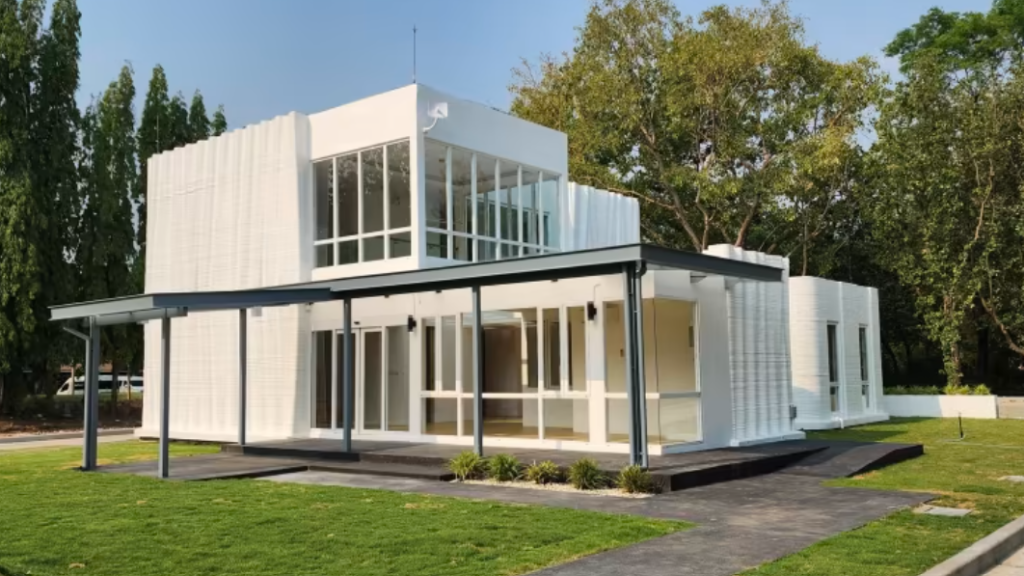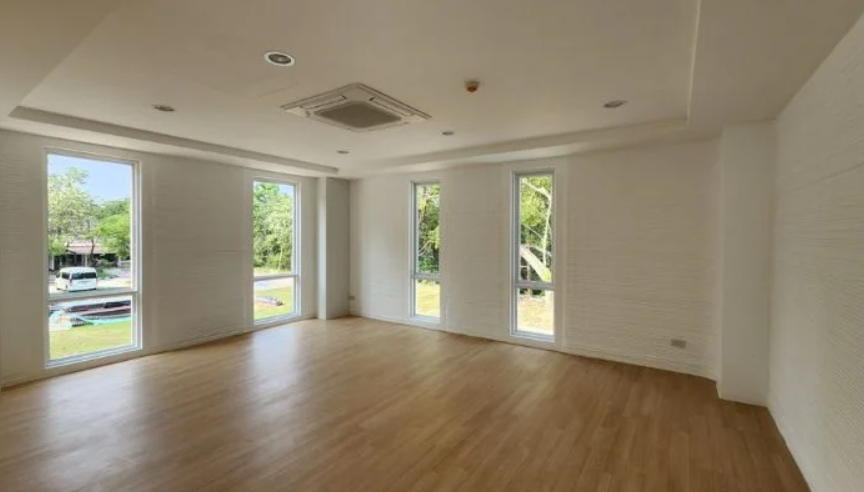Cement and building material company Siam Cement Group (SCG) has recently constructed a two-story 3D printed building.
Situated in Saraburi, Thailand, the structure is recognized as the “world’s first 3D printed medical center.” SCG utilized COBOD‘s BOD2 3D printer to construct this novel two-story building. The structure spans a substantial floor area of 345 m2 across its two levels, making it the largest 3D printed building among the ASEAN countries.
“The design of the 3D printed medical center was approved by a senior professional engineer. The materials used in this building were SCG 3D printing mortars with strength classes of C75/80 and C30/35 for load-bearing and non-load-bearing 3D printed walls, respectively. As CPAC 3D printing solution under the SCG cement company umbrella, we aim to create best practices and standards for 3D printing construction. Moreover, our commitment is to help the construction industry become more sustainable and carbon-neutral through innovation and technology,” said Chalermwut Snguanyat, 3D printing & fabric concrete technology director from SCG.

The world’s first 3D printed medical center
The distinctive feature of the building is its wavy walls, which create a notable visual impact on the surrounding landscape. This unique design was made achievable and seamlessly incorporated using the capabilities of the BOD2 3D printer, enabling “unprecedented design freedom.” Consequently, the 3D printed medical center consists several advantages inherent to this novel construction approach, including enhanced design flexibility, accelerated building speed, and a decreased workforce requirement on-site when compared to conventional construction methods. The building was meticulously designed to withstand seismic loads, and the utilization of 3D printing technology expedited the construction process.
“Besides demonstrating SCG capability to build a two-story commercial building using the COBOD printer, the project’s highlight was to implement our research on a 3D printed structure. In this building, we successfully implemented results from our collaborative studies with top-tier universities in Thailand for constructing a one-story 3D printed load-bearing structure and a two-story 3D printed non-load bearing structure,” added Snguanyat.
SCG believes it now presents an opportunity for the industry to enhance construction efficiency and minimize environmental footprint by reducing waste generation at construction sites, all while improving the overall design. Serving as an authorized distributor of COBOD in Thailand, SCG advocates for the value of 3D printing, which offers a multitude of advantages over conventional construction approaches.
Simon Klint Bergh, COBOD Co-Founder and Head of APAC, said, “Last year I was proud to announce our local partnership with SCG for introducing our technology to the Thai market. Now, the SCG team has truly shown the whole world, why they are the right partner with this fantastic accomplishment of printing a design-free structure like this. With this SCG is setting new standards for what can be done and showing the way for the market.”
COBOD’s printers have found application in Africa for constructing schools, demonstrating their versatility. Additionally, Japanese engineering company JGC has utilized the printer for a range of industrial purposes, showcasing its adaptability in various sectors. Furthermore, in Austria, construction 3D printing firm PERI has employed the technology to expand office space, illustrating its usefulness in the realm of office construction and expansion.

State-of-art construction 3D printing
Real estate development and investment company Kraus Gruppe recently announced its plans to construct the largest 3D printed building in Europe. The project is being undertaken in collaboration with cloud and data center services provider Heidelberg IT Management GmbH & Co. KG. Situated in Heidelberg, Germany its primary purpose will be to serve as an IT server hotel. To achieve this goal, Kraus Gruppe has partnered with PERI for its expertise in the field. The construction process will utilize BOD2 3D printer, which is known for its advanced capabilities. The architectural design of the walls will be a joint effort led by Mense Korte and SSV Architekten.
According to The National, the Islamic Affairs and Charitable Activities Department (IACAD) of Dubai revealed plans to construct the world’s first 3D printed mosque. The mosque will be built in Bur Dubai, an ancient neighborhood in the Arab Emirate, and will cover an area of 2,000 square meters. It is scheduled to open in 2025 and will have the capacity to accommodate up to 600 worshippers. Although the initial cost of constructing the mosque using 3D printing may be higher compared to traditional construction methods, it is anticipated that these expenses will balance out in the future. The construction of the mosque will commence in October 2023. The mosque will be constructed using a combination of raw materials and a specially-developed concrete formulation. While the sponsor behind this project has not been disclosed yet, Al Shaibani, a representative, has stated that the technology employed for the construction process will minimize material waste and enhance sustainability.
What does the future of 3D printing for the next ten years hold?
What engineering challenges will need to be tackled in the additive manufacturing sector in the coming decade?
To stay up to date with the latest 3D printing news, don’t forget to subscribe to the 3D Printing Industry newsletter or follow us on Twitter, or like our page on Facebook.
While you’re here, why not subscribe to our Youtube channel? Featuring discussion, debriefs, video shorts, and webinar replays.
Are you looking for a job in the additive manufacturing industry? Visit 3D Printing Jobs for a selection of roles in the industry.
Featured image shows The first 3D printed medical center in the world made by SCG in Thailand. Image via COBOD.



